If you like old fashioned fudge, you need to try this Classic Vanilla Fudge recipe! Not only is it great for the holidays, but perfect all year round too!
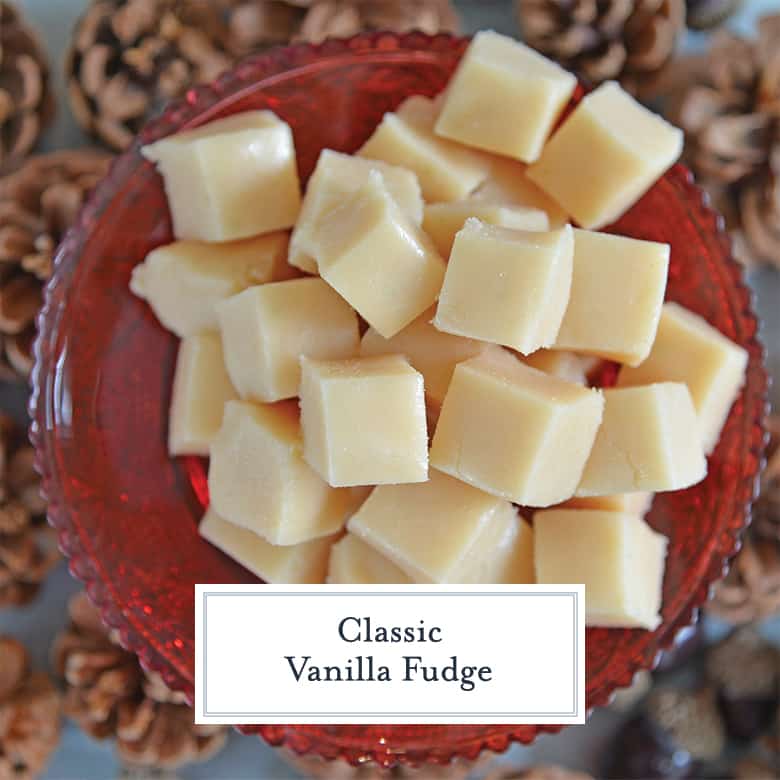
You just can’t beat a good, classic fudge recipe. Especially around the holidays.
I love all flavors and add ins, but sometimes you just need a classic vanilla. And there is no better fudge than homemade fudge!
Let me first say that making a classic or traditional fudge is hard. It seems so simple, but there is actually a lot of chemistry, patience and knowledge involved.
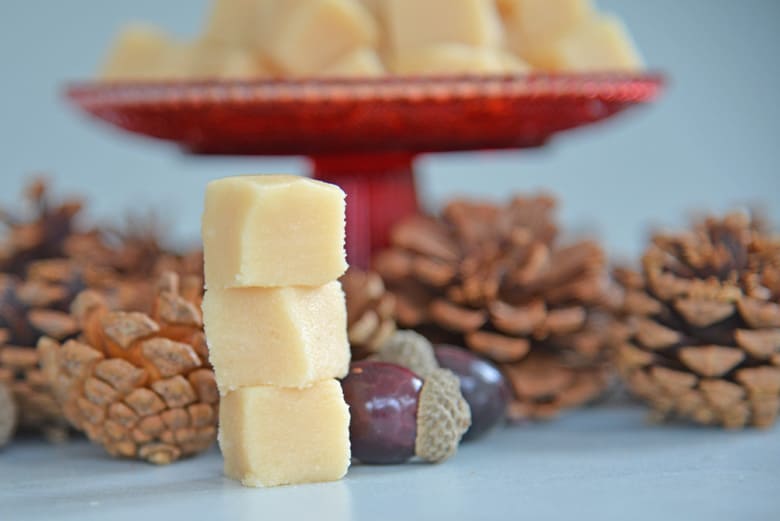
But I don’t want you to be intimidated. With the right background, tools and instructions, anyone can make delicious fudge. And I am going to share all of my favorite tips with you!
PRO TIP: Use a set pastry brush to wipe down the sides of pan to prevent sugar crystals from forming.
There are a lot of fudge recipes out there. And many take shortcuts. Don’t get me wrong, I actually make several of the easy fudge recipes myself and they are very good.
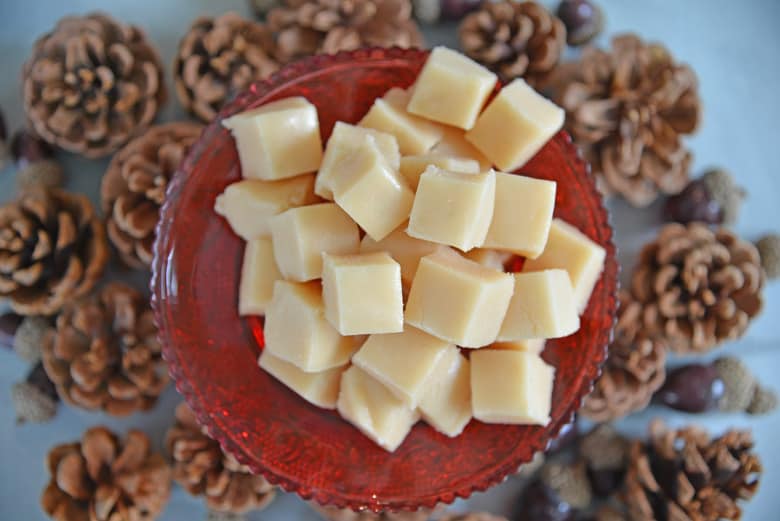
Some use marshmallow cream, like my friend over at Shugary Sweets, and others use chocolate chips and sweetened condensed milk, like my Christmas Coal Candy. Some even use whole milk, sugar and butter like my Peanut Butter Fudge.
PRO TIP: Use a wooden spoon, sticky and thick concoctions like this are easy to stir and stick less to wood than metal or plastic.
But I like to know how to make stuff from scratch and find that understanding the chemistry behind it can be quite enlightening.
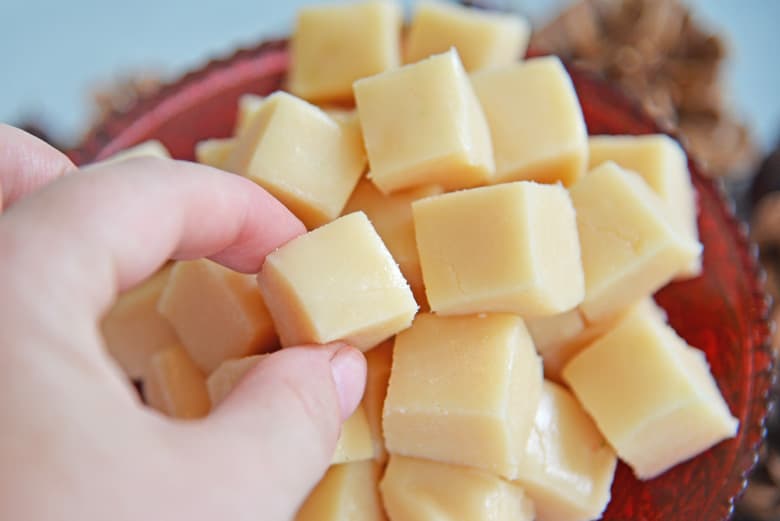
For vanilla fudge, or any traditional fudge recipe, you need to start with the mechanics. It is basically just melted sugar, but the sugar needs something to dissolve into.
PRO TIP: Don’t scrape the bottom of the pan when pouring out the mixture, if anything scalded just let it stay there.
For this you use light corn syrup, also a variation of sugar, and cream. The sugar melts and forms a soft ball, which is a stage of candy making. (See the chart below.)
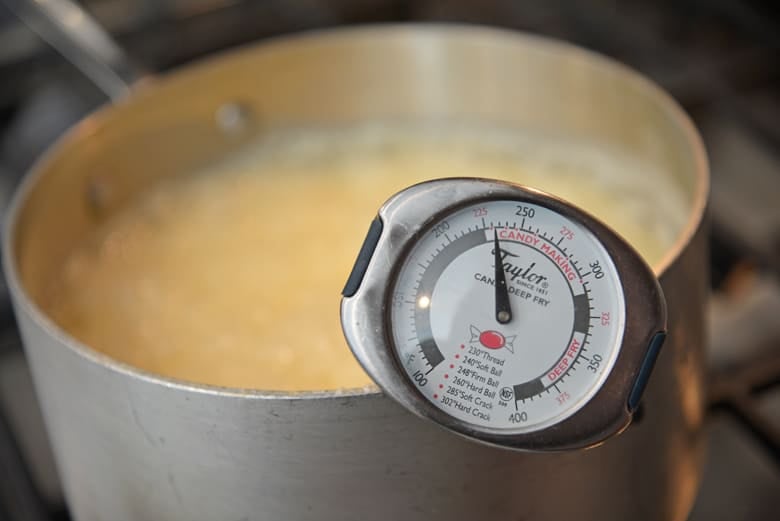
| Stage | Temperature | Concentration |
| Thread (syrup) | 230 to 234 °F | 80% |
| Soft Ball (fudge) | 234 to 241 °F | 85% |
| Firm Ball (caramel candy) | 244 to 248 °F | 87% |
| Hard Ball (nougat) | 250 to 266 °F | 90% |
| Soft Crack (salt water taffy) | 270 to 289 °F | 95% |
| Hard Crack (toffee) | 295 to 309 °F | 99% |
PRO TIP: Use a glass or metal mixing bowl and don’t touch it! I tell you to put it on a cooling rack before pouring in the mixture because after you do, the bowl is SUPER HOT. Don’t touch! Also avoid using plastic, which can melt.
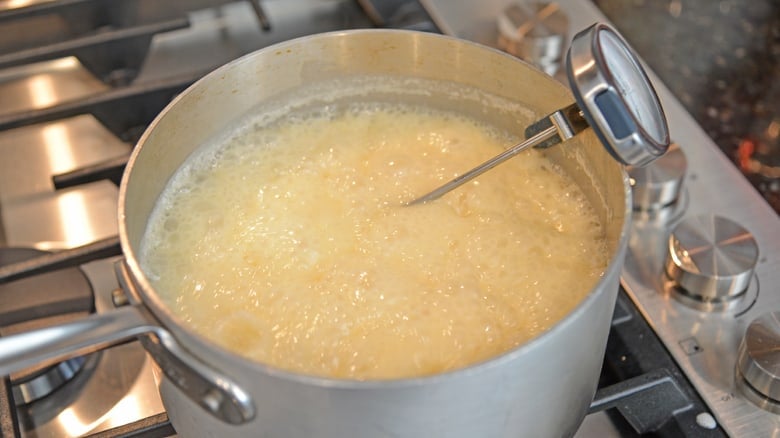
Something to keep in mind, vanilla fudge doesn’t actually need to have white chocolate in it. Fudge requiring chocolate is a misnomer. While many fudges do have chocolate or dark chocolate, this isn’t required. However, this recipe does use white chocolate.
PRO TIP: Use a stick of cold butter and wipe it on the parchment paper while flat, then place it into the 8×8 pan.
The definition of fudge is “Fudge is a type of sugar candy that is made by mixing sugar, butter and milk, heating it to the soft-ball stage at 240 °F, and then beating the mixture while it cools so that it acquires a smooth, creamy consistency. In texture, this crystalline candy falls in between fondants and hard caramels. (Wikipedia).
PRO TIP: Placing the bowl to cool on a cooling rack allows air to circulate around the whole bowl, helping the process happen faster and more even.
Make sure to use a candy thermometer to heat your fudge to correct temperture. Failing to so will result be grainy instead of smooth, melt-in-your mouth.
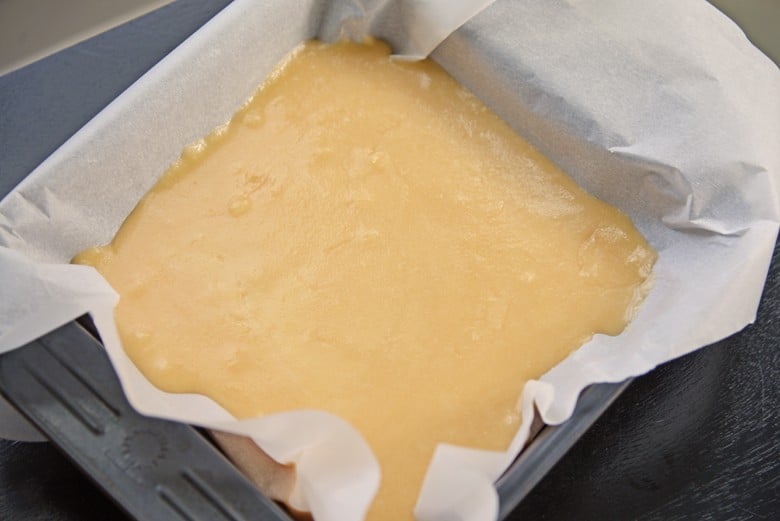
From here, we let it cool, but not too fast or else it can harden and crystalize again. It will be too hot to transfer straight to the tray, so let it come down a little in a mixing bowl.
If you use glass, be mindful that it is hot and glass it hot, so you can easily burn yourself. BE CAREFUL!
Then the fudge is transferred to it’s finally tray to harden fully into cuttable squares. The instructions may look long and tenuous, but they are really quite easy.
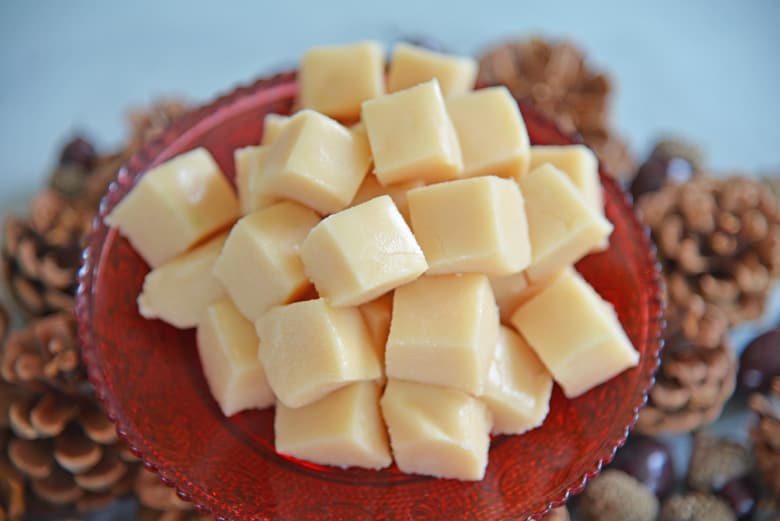
More fudge recipes:
Rocky Road Fudge Recipe
Christmas Fudge (Almond Fudge)
Easy Peppermint Fudge Recipe
Questions you might have about how to make vanilla fudge:
Why isn’t my fudge white?
Traditionally made fudge won’t be white for a simple reason, you’ve toasted the sugar and vanilla extract is brown.
There are recipes that use marshmallow fluff or sweetened condensed milk that will give you fluffy white fudge.
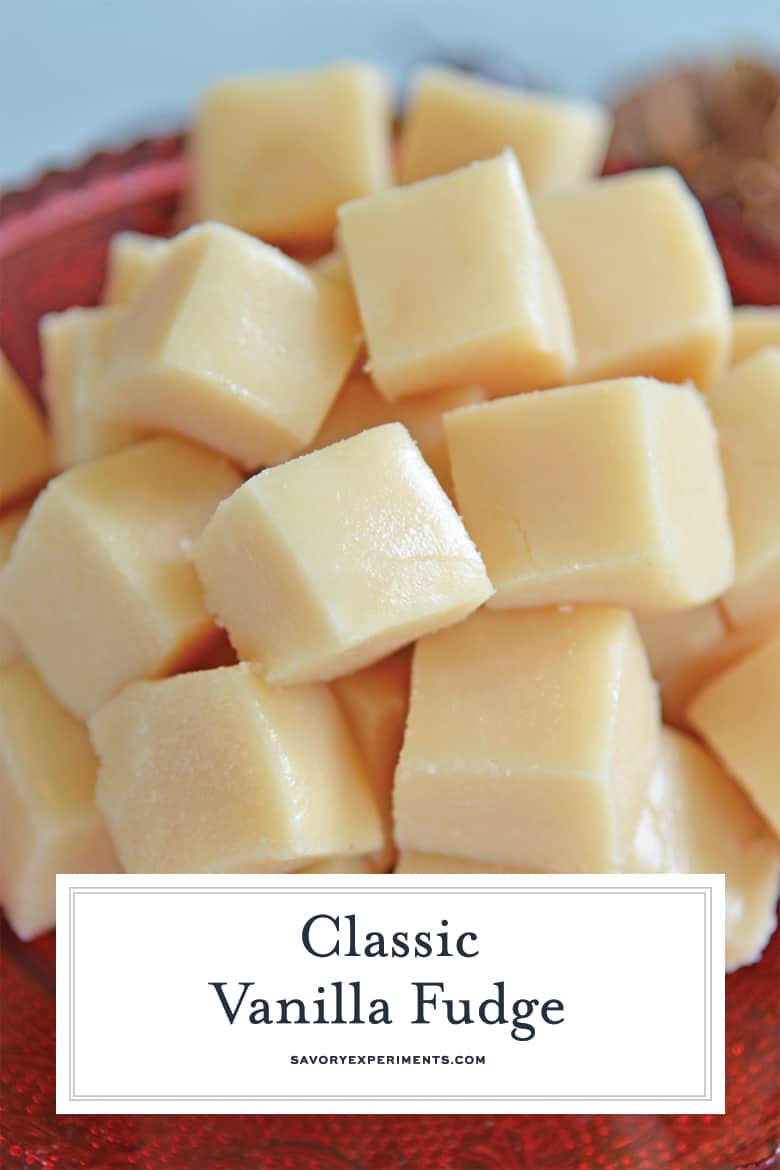
Can I use clear vanilla?
You can use clear vanilla or even vanilla flavoring, just keep in mind neither of these are real vanilla extract.
Do I have to use a candy thermometer?
Scroll up and read my several paragraphs on why a candy thermometer is imperative. The answer is yes, always yes.
When you make fudge hacks, it isn’t that big of a deal, but when you are making it the old fashioned way, you really do need one. Too little heat and it will be mealy, too much and it will be burnt and won’t set correctly.
Can I use heavy whipping cream instead of heavy cream?
Despite being used interchangeably quite often, there is a difference.
Heavy cream has a 36% milk fat while and whipping cream is only 30%. Heavy cream is better for stabilized homemade whipped cream and thickening sauces because it has a higher milk fat and thicker texture, but only slightly.
How do I store fudge?
I like to store fudge in the refrigerator, chilled, but this also dries it out faster. It can be kept at room temperature to prevent that from happening.
How long is fudge good for?
Homemade fudge is good for about a week before it starts to dry out and get all brittle. And if you love fudge like me, it will be gone way before that!
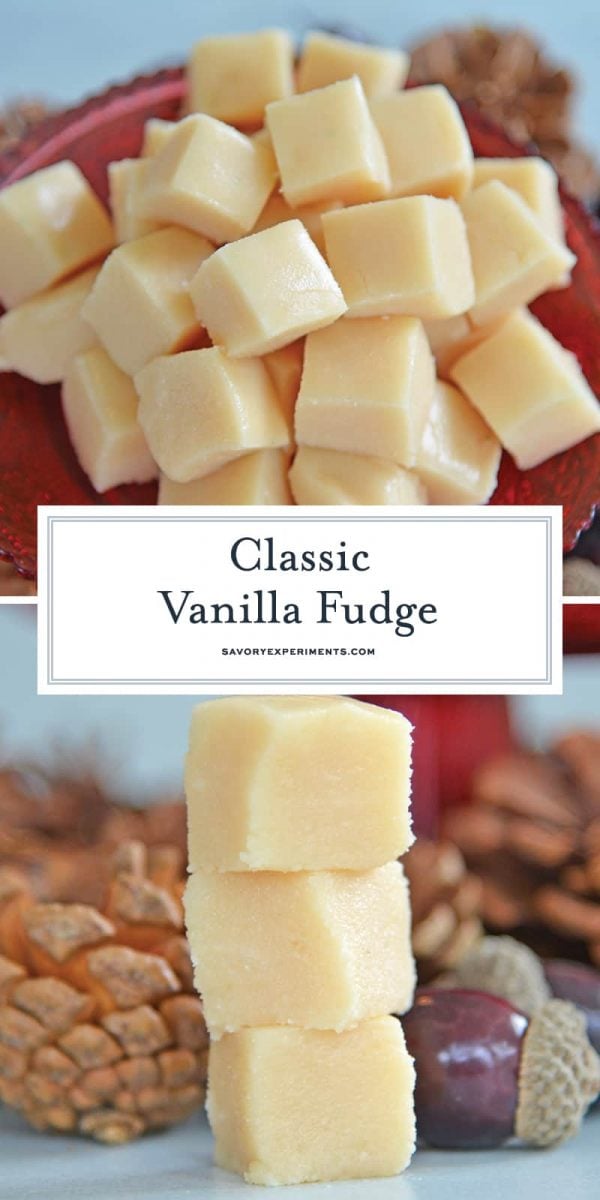
Making fudge at home doesn’t have to be challenging or time consuming. With basic knowledge of how fudge is made you’ll be a fudge making expert in no time!
Classic Vanilla Fudge
Equipment
Ingredients
- 2 1/2 cups sugar
- ½ cup white chocolate
- ¼ cup light corn syrup
- 1 ½ cups heavy cream
- ½ teaspoon fine sea salt
- 1 tablespoon unsalted butter
- 2 teaspoons pure vanilla extract or vanilla bean paste
Instructions
- Line your intended dish with parchment paper. For 1-inch thick fudge, we used a 5×8 glass dish.
- In a heavy saucepan fixed with a candy thermometer, combine the heavy cream, sugar, light corn syrup, white chocolate and salt, bringing to a low simmer until sugar and chocolate has melted, approximately 5 minutes.
- Increase the heat slightly. Do not stir or mix any longer. Allow the candy thermometer to come to 240°F (soft ball stage) and continue to cook for 1 minute. It can take 10 minutes to get to this point and the color will change from pearly white to a cream/beige.
- Carefully pour the mixture into a medium mixing bowl and then whisk in the butter and vanilla extract or paste. Do not scrape the bottom of the pan in case any of the sugar scalded to the bottom.
- Allow to cool for 10 minutes before transferring to the parchment lined dish. Cover with plastic wrap.
- Chill for at least 8 hours.
- When ready to cut, lift the parchment out of the dish and cut into pieces.
- Store in an airtight container in the refrigerator.
- If you’ve tried this recipe, come back and let us know how it was in the comments or star ratings.
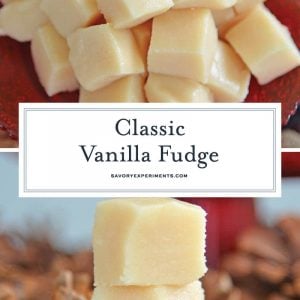
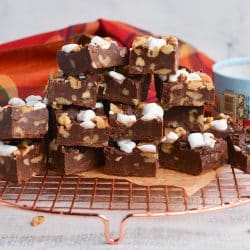
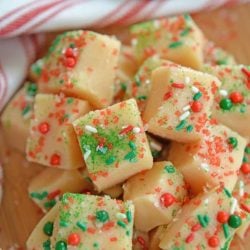
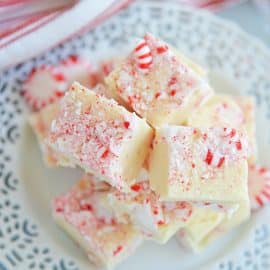
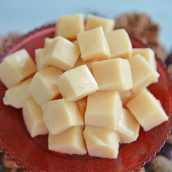
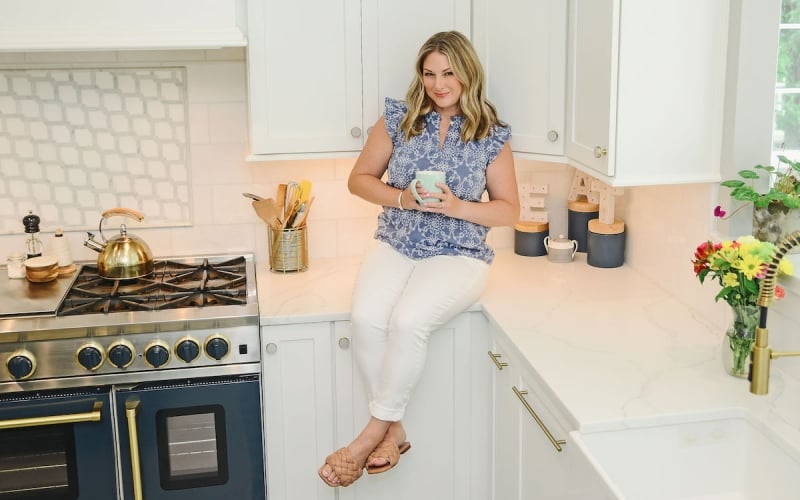
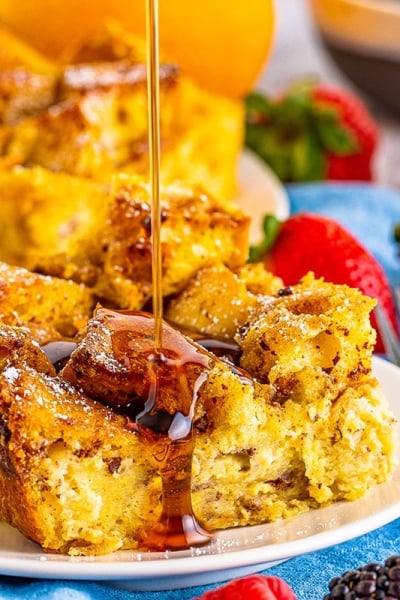
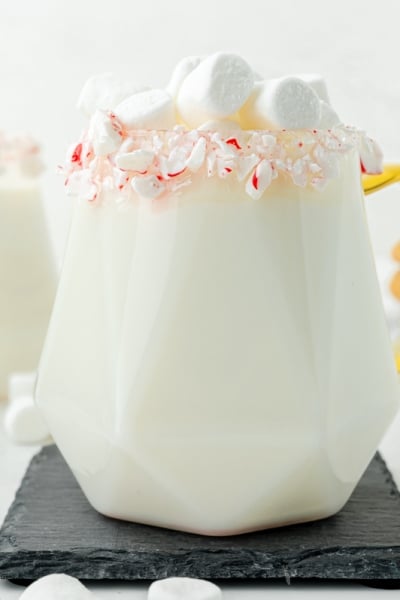
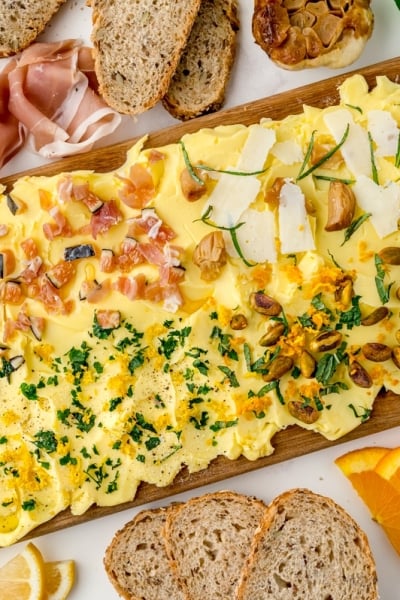
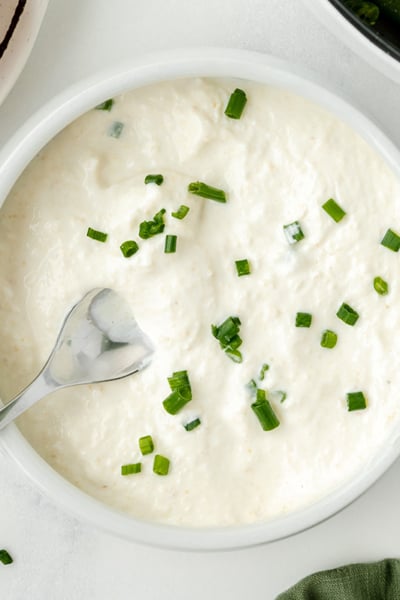













Can I use heavy whipping cream instead of heavy cream? I understand the milk fat content differs slightly.
Yes, it should be fine.
I’ve been making the Hershey’s cocoa fudge for 41 years and I wanted to try the white chocolate so I followed your steps exactly but mine doesn’t look white it’s more of a brownish color what did I do wrong? I use the candy thermometer to 240° and then continued to cook for one minute but even prior to the 240° it was starting to look brown the softball stage on the Hershey’s cocoa is 234° is that what I should cook it to or the 240°?
Hmm…. I’m thinking maybe the vanilla or the heat of your burner made it darker? Are you using a heavy bottom saucepan? It can browned, like butter, easily if the saucepan isn’t really sturdy and heavy. It might happen with dark chocolate too, you just wouldn’t see it. I’ve always done 240° otherwise it is too grainy, buy if you are getting a darker color and/or want to try the lower temp, by all means, go for it!
If I may add a side note for those getting slightly darker color: The pre-boil time is critical! I refer my students to the process of making a Roux (gravy or sauce base) and the time it takes to slowly cook out the starch and gradually darken. Same applies here, you’re making a sugar saicr! The first 10 minutes of “Tempinh” the ingredients to uniform consistency prevents one ingredient responding out of character when bringing to a boil.
Chef Geno can you please explain this in terms for the non chefs out there:) I feel like what you are saying is the answer to what I’m looking for. I have probably made vanilla fudge between 20 to 30 times already. Only the first time I made it, it came out nice and white-ish. EVERY other time it has come out different shades of brown. I can’t seem to figure out what I did so special the first time. I know it had to do with how it was heated but what??? I’ve experimented with putting it at different temperatures and different ways but cant seem to get my great first results. I’ve even experimented with different recipes. I usually just put the butter in with the heating mixer. Does that effect it? Also, for the heating do you just turn it to a low heat to make sure it doesn’t boil in the first 10 minutes? But then can you turn it up a little? Or do you continue to leave it at a low heat?
Oh, the woes of fudge making! This is a problem even for experienced cooks because it happens so darn fast! Let me ask you this- the first time you made it, when it was a snowy white color, was the texture smooth or a tad gritty? Generally it stays that pure white, but the sugar hasn’t started to caramelize, leaving it pretty, but not smooth.
The second is did you use pure vanilla extract or clear vanilla? Clear vanilla will help with this!
And the last is using a candy thermometer to make sure you have the right temp. Don’t stir it (this can make it cloudy) and wait until it just reaches the correct temp and then transfer it to a different bowl- keeping it in the same HOT pan will continue to cook it (caramelize the sugars and then they turn more brown).
But honestly, even the best fudge makers often have a more beige vanilla fudge. It is a sign of real vanilla or vanilla paste and the correct cooking temps.
Others might have a condensed milk fudge or marshmallow fluff fudge, which don’t require as much technical skill because the sugars are already melted.
Can you please tell me, for the classic vanilla fudge recipe, what kind of white chocolate do I get? What kind did you use? Will white choc chips work? Worried about it being the right texture so it sets right. Thanks so much.
Hi Mallory! You can use white chocolate chips- I used a Ghirardelli Premium Baking Bar.
I followed the recipe closely, used a Candy thermometer, and high quality ingredients, and it didn’t set, even after waiting 12-hours. I’m super disappointed.
Ugh! I am so sorry to hear that. I am going to email you to walk through it. Fudge is so temperamental!
The temperature of you house can really play a part on fudge making too is what I was taught.
I’m a little upset this fudge recipe did not turn out to set. I tried to cut it after leaving in the fridge for more then eight hours! It keeps sticking to the knife when I cut it out will not cut solid. It’s a gooey mess.
Hi Amber, I’m sorry it didn’t work for you. Did you use a thermometer and make sure it got to the correct temp for the right amount of time? Old fashioned fudge is certianly stickier and less hard than commercial fudge, but should be cuttable.
We just started making fudge recently. I will try this next.
This vanilla fudge was off the chain good. I think next time I better make a double batch! The family has been devouring it!
Made this for the family and it was a hit!
I love making a variety of fudge during the holidays to pass out as gifts…surprisingly, vanilla fudge is one I’ve never attempted. This recipe looks simple and easy to follow, and I look forward to trying it!
What a great idea to make vanilla fudge. Looks delicious!